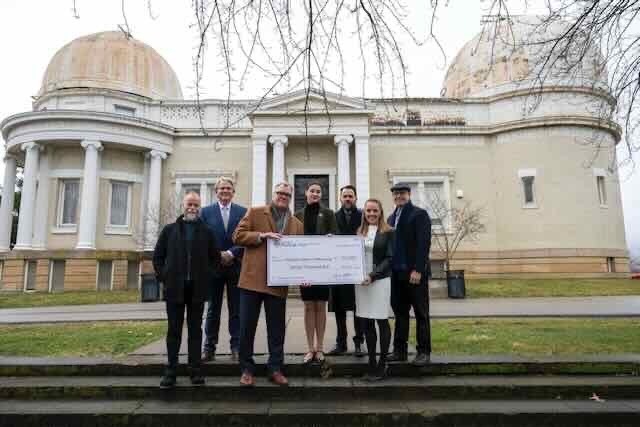From India’s moon landing in August to Jeff Bezos’ visit to space, the final frontier is experiencing a sudden boom. According to the Space Foundation, in the first six months of 2022, 1,022 spacecraft were placed in orbit globally. That is more than were launched into orbit for the first 50 years of the space age.
Astrobotics, a Pittsburgh based aerospace company, launched their Peregrine Mission One on Jan. 8, which attempted to send five payloads to the moon for NASA.
“All of the building of this spacecraft happened in Pittsburgh,” Zoë Karabinus, program director for the Keystone Space Collaborative, said. “This was the first attempt to send the United States back to the moon in 50 years, and that’s coming out of our region. That’s a huge impact. It’s really demonstrated that people are excited about space again.”
The Keystone Space Collaborative is a nonprofit organization which connects industry and academia in the Pennsylvania, West Virginia and Ohio region. Pitt’s Space Initiative, a group of 45 researchers from across the University who are interested in space, recently joined the Keystone Space Collaborative.
According to Karabinus, the current international value of exploring, researching and utilizing space, known as the global space economy, is valued at over $469 billion. This number is expected to increase as interest in space research grows and as space becomes more accessible, with some estimates predicting it to become a trillion dollar industry by 2030.
Karabinus said this partnership shows Pitt’s priorities in working regionally to boost its space offerings as a large part of the regional economy. Karabinus said she is excited about this new partnership with Pitt.
“It really shows Pitt’s priorities as a university,” Karabinus said. “It really demonstrates a major university is thinking critically and is very engaged in an industry that a lot of universities kind of have yet to see the value in.”
Karabinus said space research is becoming increasingly accessible. According to NBC News, research costs have decreased from about $30,000 per pound in the 1960s — adjusted for inflation — to $1,200 per pound.
Alan George, a department chair in the electrical and computer engineering department, said the growing accessibility of space allowed for large companies like SpaceX and Boeing, and even smaller companies like Astrobotics, to drive what is happening in the space community.
“Back in the ‘60s and ‘70s, it was all government driven, and all government funded,” George said. “It isn’t that way anymore. Now, the government plays a role, but not the lead role, or not necessarily the central role. They play a critical role, but so do universities and companies as well.”
Pitt’s space initiative is focused on three areas — space medicine, space engineering and space science. Rob Cunningham, vice chancellor for research infrastructure, is leading the initiative.
Cunningham said space medicine research involves a lot of interesting and novel science. According to Cunningham, an essential part of maintaining a healthy bone density is gravity. If astronauts spend long enough times in space, this could potentially be harmful.
“Pitt is interested in exploring implications of being in space for long periods of time on the human body and on animals as well,” Cunningham said. “Also, it turns out there are certain things that you can build in low gravity situations, like orbits around the Earth, that you just can’t build down here. Pitt wants to research certain drugs and certain compounds up in space.”
According to Cunningham, Pitt runs the largest center for universities to collaborate with industry in the nation. The Center for Space, High-Performance and Resilient Computing leads the field in space architecture.
The space initiative informally began when Cunningham posted announcements about a lunch and learn for faculty to gauge faculty interest in space. He said he wasn’t sure about interest at first, but he ended up receiving a good turnout.
“45 faculty showed up for a half-a-day meeting on space. And that was astounding. I mean, I literally thought we probably would have 10 and we would sort of do something at a small scale,” Cunningham said. “But when 45 faculty show up, that’s a very strong signal that the faculty are interested in building something bigger in space.”
Professors from departments in the School of Engineering, Dietrich’s physics and astronomy department and even members from Pitt’s School of Dentistry make up Pitt’s space initiative.
David Turnshek, a professor of physics and astronomy and a chair of the Allegheny Observatory, said he thinks joining the collaborative is a smart idea because it expands professional networks.a
“I can appreciate Rob Cunningham’s thinking that there is some advantage to having an umbrella somehow connecting all of us,” Turnshek said. “There’s a lot of smart people, even just in the University. And a very smart person might say, why aren’t you doing this? What about this? Did you ever think of doing something the following way? Through that discussion, something may percolate into a good idea.”
Cunningham said the Keystone Space Collaborative is focused on the tri-state region, so one of the main hopes is that industry within the region will continue to expand.
“In addition to sending some of our students to NASA, and we do, we want a few of them to stay here and work for companies and build a space ecosystem in and around the University of Pittsburgh,” Cunningham said.



